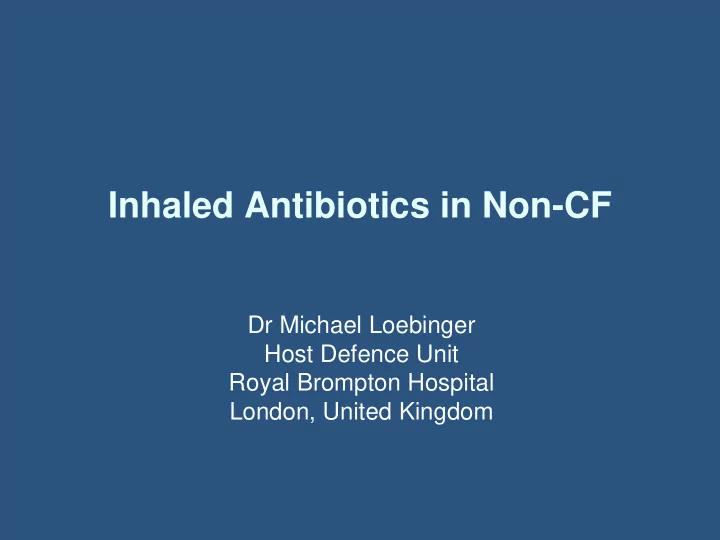

Inhaled Antibiotics in Non-CF Dr Michael Loebinger Host Defence Unit Royal Brompton Hospital London, United Kingdom
Advantages Increased drug concentrations locally Reduced systemic adverse effects Home treatment
Role Prophylaxis / chronic management Eradication Acute Treatment Bronchiectasis Pneumonia
Chronic management
Nebulised colomycin studies Study Study N Medications Study Outcome Side effects design time-frame Steinfort Prospective, 18 Nebulised Average Three patients showed No resistance 2007 open-label 14 Bx colistin 30 mg in 41 months improved FEV 1 and increase side effects 2 ml od 6/12 rv in patient-reported quality of life Dhar Retrospective, 19 Nebulised Average Significant decrease of PA No side effects ↓ exacerbation frequency 2010 open-label 17 completed colistin 1–2 21.2 months megaunits 6/12 rv (7.8 to 2.7/year, P <0.001) twice daily • Improvement in PFT, exacerbations, micro BUT small uncontrolled studies • International multicentre RCT with primary endpoint time to next exacerbation will report soon.
Nebulised tobramycin studies Study N Medications Study time-frame Outcome Side effects ↑ incidence of ↓ Colonisation with PA in 74 Inhaled tobramycin 4 weeks with 2-week Barker 2000 37 tobramycin 300 mg twice daily washout dyspnoea (32%), treatment arm (35% 37 placebo resistance 11% eradication at week 6), possible subjective symptomatic improvement 41 Inhaled tobramycin Open label Eradication of PA in 22% at 10% dropout Scheinberg 300 mg twice daily Three cycles of week 12, resistance 7% 2005 2 weeks on/2 weeks off QoL therapy 30 Inhaled tobramycin 6 months, 1-month No change in exacerbation No resistance; Drobnic 20 completed 300 mg twice daily washout and crossover frequency or quality of life, 10% bronchospasm 2005 ↓ number of hospitalisations 5 died for 6 months in treatment arm Significant ↓ hospital days Orriols 1999 15 Ceftaz and tobra vs Open label 1 pt withdrew symptomatic Rx 12 month bronchospasm and admissions No change in FEV 1 • Some ↓hospital, micro, but resistance and side effects
Nebulised gentamicin studies Study N Medications Study time-frame Outcome Side effects 65 Neb Gent 80mg bd 12 months, 3monthly rv Bacterial eradication: 31% PSA , No resistance Murray ↑ incidence of 93% other pathogens vs HTS 2011 ↓ Sputum purulence ( P ≤0.02) dyspnoea (32%), ↑ Exercise capacity ( P =0.03) chest pain and ↓ Exacer 0 (0 –1) cf 1.5 (1–2) wheezing in treatment ( P <0.0001) arm Better quality of life: LCQ and SGRQ • Improved clinical and micro end points, but not sustained.
New formulations
New formulations Phase N Description Result primary endpoint Therapy Significant ↓ in PA density in the 560 mg II 61 Inhaled liposomal amikacin 280 mg Liposomal amikacin for or 560 mg once daily for 28 days arm vs placebo 1,2 Inhalation Aztreonam for Inhalation II 89 Nebulised aztreonam for inhalation Statistically and clinically significant Solution (AZLI) solution 75 mg three times daily for improvement in respiratory symptoms. Significant ↓ of PA (>99%) and non-PA 28 days (98%) Gram-negative density 3 Phase III (AIR BX1 and AIRBX2 recruiting) Significant ↓ of PA density 4.2 log units vs Dual Release IIb 42 ARD-3150 and placebo once daily for Ciprofloxacin for 28 days then 28 days off treatment for 0.1 log units placebo ( P =0.004) 4 Inhalation (DRCFI) three cycles Significant difference in median time to first ARD-3150 exacerbation (DRCFI 134 days vs. placebo 56 days (P=0.046) 5 Phase III study in preparation Significant ↓ of total bacterial counts in ITT Ciprofloxacin DPI II 124 Ciprofloxacin DPI 32.5 mg or placebo twice daily for 28 days plus 2 months’ population 3.6 log units vs 0.3 log units follow-up Phase III study in placebo ( P =0.001) 7 preparation • Predominantly micro end points, but clinical endpoints needed.
Treatment - Eradication Pseudomonas No specific studies CF Ciprofloxacin and nebulised colomycin 3/12 (16% vs 72% historical controls) TOBI (ELITE) Recent comparison cipro + TOBI / Colo
Treatment - Exacerbations Study N Medications Study time-frame Outcome Side effects Significant ↓ of PA in sputum, Bilton 2006 53 Oral ciprofloxacin 2 weeks followed by 50% on tobramycin 43 completed 750 mg plus 1 week follow-up developed wheeze 35% cf 19% inhaled tobramycin compared with 15% ↓ in FEV 1 while on tobramycin 300 mg or placebo on placebo ( P =NS) bid • microbiological but not clinical improvement
Pneumonia - VAP Study Study N Medications Outcome design Ioannidou 2007 Metaanalysis 5RCTs, 176pts Tobra, gent, Improved cure, no mortality effect sisamycin Michalopoulos Prospective, 60 Nebulised colistin 83% bact and clinical response 2008 open-label 57received iv Rx No control group Ghannam 2009 Retrospective 32 cancer and IV colistin/amino Increase complete resolution and VAP With Neb 16 micro eradication Without Neb 16 Korbila 2010 Retrospective 121 IV colistin Cure rate 79.5% cf 60.5% With Neb 78 Without Neb 43 Kofteridis 2010 Retrospective 86 IV colistin No difference With Neb 43 Without Neb 43 Korbila 2010 Retrospective 121 IV colistin Cure rate 79.5% cf 60.5% With Neb 78 Without Neb 43 Lu 2011 Phase 2 RT 40 20 IV ceftaz/ami No difference in outcome, more 20 Neb ceftaz/ami resistance in IV group
Treatment New formulations – Amikacin Not yet well supported by studies Some rationale for concurrent use in VAP
Others NTM – amikacin Pneumocystis – pentamidine Fungal infection - amphotericin Pneumonia prophylaxis Other chronic resp conditions
Challenges Evidence Which patients Optimal regimen and delivery Regrowth after use Resistance Patient Community Bronchospasm Cost Burden
Conclusions Poor evidence Good rationale Established use in bronchiectasis Less so in VAP Increasing interest Increasing number of products, studies, trials
Recommend
More recommend